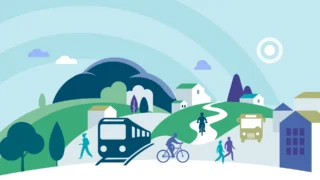The WDC recently made a submission to the Department of Transport, Tourism and Sport (DTTAS) consultation on the Review of Sustainable Mobility Policy and associated background papers.
One of the functions of the WDC is regional policy analysis. The WDC seeks to ensure that government policy reflects the needs of, and maximises the potential of, the Western Region[1] in such areas as infrastructure, natural resources, enterprise and regional and rural development. It also tracks the implementation of policies and recommends adjustments as appropriate.
As the Western Region is very rural[2] the WDC submission has a particular focus on the needs of, and opportunities for, more rural and peripheral areas.
The Sustainable Mobility Policy consultation was organised around a number of specific topic issues with background papers prepared by DTTAS for each of these. In this post some of the key points made in the submission for each topic are highlighted but the full submission can be read here.
Active travel
Active travel tends to be less popular in rural areas and in smaller urban settlements. There are a number of reasons for this, including:
- The need to travel longer distances to employment or services
- A lack of walking and cycling facilities
- Motorised transport travelling at higher average speeds giving rise to concerns about personal safety
- Greater exposure to wind and rain
- Lack of artificial lighting meaning that many journeys are difficult in the hours of darkness
- Finally, less congestion and more predicable travel times in rural and small urban areas also reduce the incentive to walk or cycle.
Despite these issues Active Travel options should be more available and promoted in rural and small towns so that the proportion of active journeys is increased to the benefit of both the individual travellers and the wider community.
Normalising walking and cycling as viable travel options in rural areas is important. They shouldn’t be considered unusual, risky or the preserve of a small minority. This normalisation will of course occur as participation increases, but also as the infrastructure for active travel is increased and the options are more visible and safer.
Climate Change Challenge
Addressing the decarbonisation of transport and travel in rural regions is complex. Rural people are more reliant on car based transport, they have less available public transport and tend to travel greater distances. Rural dwellers’ transport and travel patterns need to be central to our Sustainable Mobility Policy.
The rural nature of the Western Region has implications for how we reduce transport emissions, but the reasons we travel are also very important, both in terms of options for reducing journey numbers and types, and the distances and nature of the journeys.
The three pronged ‘Avoid, Shift, Improve’ (ASI) framework is a hierarchy that emphasises reducing journeys in the first place, achieving modal shift, and improving mode efficiencies[3] and should be used for rural transport planning. By thinking of each of these (ASI) in relation to rural journeys we can begin to focus on workable solutions
The WDC is currently engaged in a project on the transition to a low carbon economy in the rural Western Region (under Action 160 in the Climate Action Plan) and transport is one of the key elements under consideration.
Congestion
The costs of congestion are significant and varied, impacting on efficiency, economics and societal and individual wellbeing. Within the Western Region the larger towns and Galway city are particularly affected. It is important that congestion is eased, both to reduce the economic and social costs being incurred, and also to ensure the Region and its growth centres can deliver on the ambitious regional growth targets set out in Project Ireland 2040.
Within the Western Region, congestion in Galway city is of most concern. The Galway Transport Strategy has identified various sustainable mobility measures which need to be expedited. Funding from national Government must be made available to ensure speedy delivery. There needs to be an expansion of commuter rail services on the existing Athenry-Oranmore-Galway city route. This will relieve congestion and help promote other sustainable transport (walking and cycling) within Galway city. Investment is needed to double track this line, provide passing bays in the short term and procure additional carriages.
Regional towns will need support and investment in devising and activating sustainable mobility town plans. Support from the expertise available within the NTA and local authorities should be made available.
The WDC has been active in the area of remote working (previously termed e-work and telework) for many years, researching the practice, as well as operating an e-work policy for over two decades. We have published various papers including a recent blogpost which identifies the most recent evidence which suggests that that 18% of workers declared they worked from home. See the blogpost for more detail. The success of initiatives variously called e-working spaces/ co-working spaces/ hubs also suggests e-working is on the increase. These can provide similar benefits to home working in reducing commuting distance and congestion.
Land Use Planning and Transport Planning
The integration of land use and planning is important in generating more sustainable mobility. Many people working in congested centres, especially Dublin, have to endure long commute times. If more employment was located in regional centres then it is likely many would have shorter commute times, with much less investment and funding required to ease congested networks in the Greater Dublin Area for example.
One of the important contributory factors to the recent and current pattern of development is the focus on transport investment to and from the capital with relatively minimal investment in other inter-city routes. Some of the current congestion or ‘over development’ of Dublin is in part a legacy issue relating to the priority given to improving the radial road links (and rail links) between the provincial cities and Dublin which ensured that Dublin was the most accessible city while at the same time there were relatively very poor intraregional links between each of the other cities, stifling development within and between the other regions.
Regulation of Public Transport
The remit of the National Transport Authority (NTA) which confers additional responsibilities within the GDA should not be confined to the GDA but should be extended to the entire country. The particular additional responsibilities allow the NTA to more effectively deliver on the transport needs of the GDA and this overall, comprehensive role is needed throughout the country.
Given the role of the NTA in delivering the Rural Transport programme, the investment programme in regional cities, the accessibility programme, and other transport programmes, it already has a significant role and understanding of transport issues outside the GDA. What is needed is the capacity to deliver overall strategic direction so as to enhance and integrate services across the country and beyond the GDA.
The background document notes that the majority of bus and rail services are PSO routes. These are ‘financially unviable services which are provided as a public good’. In this discussion it would be useful to note that this is not unusual, that most public transport services arose Europe are in receipt of public funding. The services provide wider economic benefits which are often not quantified but are no doubt significant.
Public Transport in Rural Ireland
Rural areas (depending on the definition used) can include some significant towns which have different transport patterns and needs to the more sparsely populated rural areas. It is important that these differences are recognised in planning for rural transport and that one approach is not assumed to cover all rural issues.
Most journeys are made to reach services of varying kinds. People living in rural areas tend to be at a greater distance from services than their urban counterparts and so the journeys made tend to be longer and more car based and of course those without access to a car are particularly disadvantaged. Greater distance to services tends to reduce options for travel and in particular, given the lack of public transport and the distance to public transport services, increases reliance on car travel in rural areas[4]. There are opportunities and challenges in providing public transport in rural areas, some of which are noted here:
- Existing public transport like school bus services and other transport services (health) should be open to all rural dwellers, making the most of the existing services.
- Where a service exists bus stops, signage and information should be available including covered bus shelters (discussed more in the Active travel section of this submission)
- Bike parking stops which is secure and dry should be provided at rail stations and key bus (discussed more in the Active travel section of this submission)
- An Information app on availability/ timing would be useful. Sometimes it can be difficult to find information about an existing service or predict when it might arrive.
- If a phone service is used to provide information about the transport service or to allow for demand response this needs to be staffed daily ideally from 7am to 7pm. If you cannot rely on being able to contact the service to book or check timing the service will not be used to its potential.
Statistics and Trends
There seems to be a shortage of data on public transport provided by private operators. These account for a significant proportion of scheduled services between cities and towns in the Western Region but there is little data on passenger numbers, frequency etc. This can sometimes lead to underestimation of the use of public transport not provided by Bus Éireann or Irish Rail.
Many journeys are multi modal, and yet there is very little information on such journeys with the main mode often being the only information gathered. Better data on multi modal journeys would allow for infrastructure and services to be planned taking it into account. Similarly, with better understanding of the roles of different modes in different journey types, the more sustainable modes can be encouraged as elements of a journey.
Priorities
There has long been a focus on sustainable travel in Dublin, but less focus on other cities (e.g. Galway) and other urban centres (such as Sligo and Ennis). Likewise in small towns it is not prioritised or is included as an add-on. Solutions may not be well designed or not attractive to users or may not be integrated so that they are not practical for users. Finding out what works in smaller urban centres and making good investments is important.
There is a dearth of sustainable travel options and solutions available for rural areas, and if we are to reduce the carbon intensity of rural travel there needs to be a clear focus on finding solutions in rural areas, piloting infrastructural investments in rural areas and small towns and trying novel approaches to encouraging sustainable travel. We need to find out what works in rural areas in relation to lift sharing, public transport use and active travel so potential solutions can be developed, then tested, learned from, and put in place elsewhere.
The full submission from the WDC is available here.
Helen McHenry
[1] There are seven counties under the WDC remit Donegal, Sligo, Leitrim, Mayo, Roscommon, Galway and Clare
[2] Using the CSO definition 64.7% in of the population live outside of towns of 1,500 or more. Using the definition in Ireland 2040 the National Planning Framework, 80% of people in Western Region live outside of towns of 10,000.
[3] See more discussion in the NESC paper Advancing the Low-Carbon Transition in Irish Transport
[4] Discussed more here https://wdcinsights.wordpress.com/2019/12/20/why-do-we-travel-distance-to-rural-services-and-the-need-for-rural-journeys/





